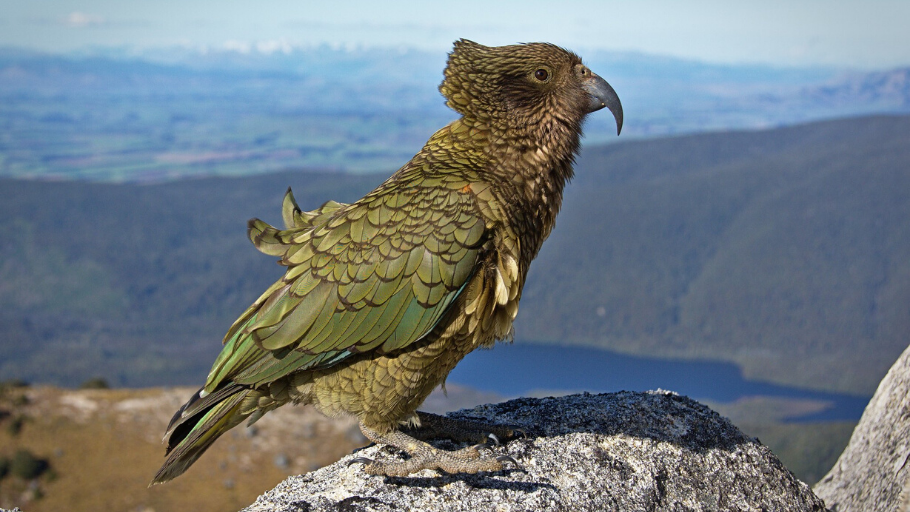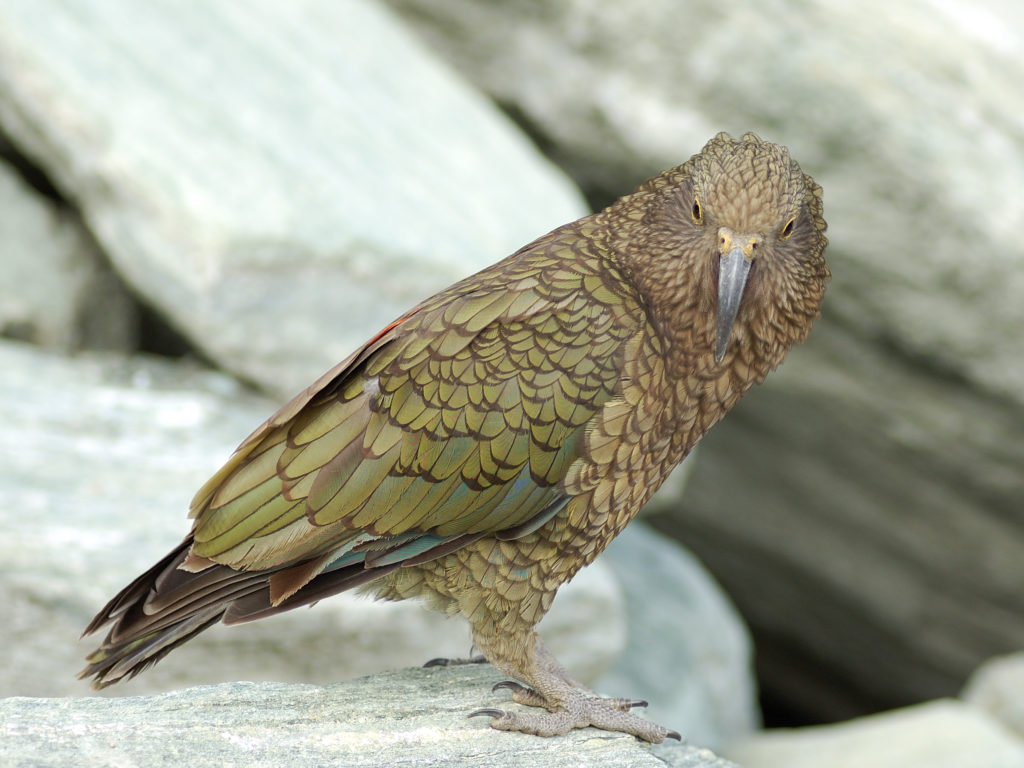Not only do kea nest on the ground, but it takes about 4 months from egg-laying until kea chicks fledge. Four months is a long time to be sitting on the ground facing off the local stoats. Kea eggs, chicks and even adult incubating females are very vulnerable to predation.
Aerial application of 1080 can knock back the predators, but the timing needs to be right and the benefits to nesting kea must outweigh the known risks that some kea will eat the bait themselves.

So do more chicks survive to fledge? Department of Conservation Biodiversity Group researchers Joshua Kemp, Corey Mosen, Graeme Elliott and Christine Hunter investigate, in a paper recently published in the New Zealand Journal of Ecology.
“Mammal control for biodiversity conservation in New Zealand commonly involves the aerial application of cereal-pellet baits containing sodium fluoroacetate (‘Compound 1080’), but its effectiveness for kea conservation has not previously been assessed. This study presents an experimental test of the hypothesis that large-scale aerial 1080 in the spring of a mast year improves the productivity of kea over two subsequent nesting seasons, during which predator abundance would normally be elevated.”

“This study is particularly important for kea, as they are one of a few native species for which significant negative consequences of aerial 1080 have been detected (non-target poisoning). Quantifying the benefits of aerial 1080 for kea populations is essential to objectively determining the value of this management method for kea.”
The researchers carried out their study in a lowland rimu forest on the West Coast of New Zealand’s South Island. Kea in lowland rimu forest? Many of us think of the kea as our ‘alpine parrot’ – a bird that lives above the treeline in our Southern Alps, but that is something of a misconception.
A stunning photo of a juvenile kea in flight, by kea researcher, Brent Barrett.
“Despite evidence that the kea is essentially a forest parrot, there is a popular misconception of a purely alpine (high-altitude, above treeline) distribution. This view arises because kea are cryptic in the forest and humans more often encounter them whilst tramping and skiing in the alpine zone.”
“The kea population is difficult to manage because the species is spread very thinly across a large range (c. 4.5 million ha). If introduced predators are limiting kea numbers, predator control programmes will need to cover hundreds of thousands, or possibly millions, of hectares to conserve sufficient kea habitat to support a population with adequate genetic diversity.”
Predator control is particularly important after a ‘mast year’ when heavy seedfall can lead to a much higher number of mice, rats and stoats, but the population dynamics can be complicated.
“The resource pulse associated with masting manifests early in a mast year and can last until the following spring, during which time rodent populations (rat and/or mouse) increase exponentially. High rodent density leads in turn to a stoat irruption during the post-mast year (the year after the mast year).”
Some native species are vulnerable to the increased numbers of mice and rats. Other bird species may only become vulnerable later in the cycle, once mouse and rat numbers reduce and the stoats that have been preying on them start looking around for other food.
“As a result, there is variation in the time within masting/irruption cycles at which predator impacts on native species are most acute. The timing of predator control, therefore, needs careful consideration and may vary among forest sites depending on threatened species assemblage, predator species assemblage and abundance between masts, and the masting propensity of the dominant vegetation. How to time predator control to benefit a broad range of forest flora and fauna, while prioritising the needs of threatened species (birds, bats, lizards and invertebrates) is the focus of current research by the Department of Conservation (DOC).”
Because masting continues to affect predator/prey dynamics beyond the actual mast year, the kea investigation looked at more than just one breeding season.
“We measured three parameters which collectively describe annual reproductive success (nesting frequency, nest survival and final chick count), within a Before-After-Control-Impact experiment. The Impact site was a 30,000 ha area over which 1080 baits were aerially applied in the spring of a rimu mast year (i.e. with heavy seedfall), with the After phase of the experiment lasting for two kea nesting seasons.”
As expected, aerial 1080 application successfully reduced predators. Ship rat, house mouse, brushtail possum and stoat, which are potential predators of kea nests, were much less abundant in the Impact site (Okarito) after 1080 application, on the basis of standard indexing techniques.
“Footprint tracking tunnel surveys showed increases in the relative abundance of rats at both sites during the 2011 mast year. However, the first post-1080 tracking tunnel survey, conducted two weeks after the 1080 drop, recorded less than 1% tracking for both rats and stoats at Okarito. Conversely, rats and stoats continued to increase at Fox–Paringa, with rats peaking at > 80% tracking during summer-autumn 2011–2012. A natural post-irruption rat decline during winter 2012 brought this rat tracking index down to pre-irruption levels of 10–30%. In contrast, rat abundance at Okarito increased during 2012. Mouse tracking increased temporarily at Okarito during the period of suppressed rat tracking following the 1080 application.”
Crucially, stoat numbers remained low for the following two kea breeding seasons.
“Stoat FTI remained near zero at Okarito for the kea nesting seasons in 2011 and 2012. Conversely, at Fox–Paringa, stoats were relatively abundant during 2012. The difference in rat and stoat tracking indices between the two sites suggests that a high proportion of both rats and stoats were killed at Okarito by the 1080 treatment. Possum Residual Trap Catch Index (RTCI) measures during the Before phase of the experiment were 5.9% and 6.3% at Fox–Paringa and Okarito, respectively. Possum RTCI during the After phase was measured only at Okarito, where a reduction to 0.5% was recorded.”

So what sort of difference did it make to kea nesting success at the Okarito ‘Impact’ site?
“There was strong statistical support for an effect of aerial 1080 on kea nest survival. Aerial 1080 improved the odds of daily nest survival by a factor of 9.1 at the treatment site. Nest survival rates in the Control and Impact sites, before the application of 1080, were 21% and 46.4%, respectively. After the application of 1080 to the Impact site, nest survival increased to 84.8% in this site, whereas it declined to 12.2% in the untreated Control site. This substantial positive effect of aerial 1080 on kea nest survival is attributed to the effective control of mammalian nest predators, particularly the secondary poisoning of stoats.”
It’s a pretty substantial difference in nesting success between the sites.
“Only one of fifteen nesting attempts failed at Okarito during the two breeding seasons after 1080 treatment, whereas ten out of thirteen nests failed in the untreated Fox–Paringa site, including seven failures out of seven nests during the stoat irruption year of 2012. These results are consistent with differences in predator abundance (principally stoats) between the sites, which are attributable to the application of aerial 1080 at Okarito. We attribute the more prolonged period of stoat suppression and associated improvement in kea nest survival at Okarito to the larger area (30 000 ha) of this site and its extensive natural barriers to reinvasion by predators (ocean to the west, permanent snow and ice to the east).”
“Our result of a positive effect of aerial 1080 application on kea reproductive success should be directly applicable to other large-scale aerial 1080 operations in South Island forests with similar predator assemblages and masting dynamics. Our lowland rimu forested study area in Westland is characteristic of about 20% of the current kea breeding range. The remaining 80% is comprised mostly of upland beech forests and mixed beech–rimu forests, both of which also exhibit mast seeding dynamics. Fortunately, comparison of our predator indexing results from Westland with those from upland beech forests (see Elliott & Kemp 2016) shows that predator dynamics are very similar between the two.”
There was, however, a brief period in 2012 when rat numbers at Okarito increased following 1080 application and that is potentially a problem for some, more vulnerable bird species and invertebrates.
“A medium-term increase in rat carrying-capacity could be attributed to the combined absence of predation by stoats on rats and increased food availability due to suppression of rats and possums. While this study demonstrated clear benefits of aerial 1080 for kea reproductive success over two years, the effect of this medium-term rat increase on smaller rat–sensitive native inhabitants of lowland 1080–treated forests requires attention.”
Similar research on 1080 impacts and predator/prey dynamics, particularly following a mast year, is currently needed for other species, the authors believe.
“Further measurement of benefits of aerial 1080 to a range of native species of various body size and predator vulnerability is required so that the national 1080 programme can be tailored to benefit whole forest communities. In summary, our results indicate that large–scale aerial 1080 operations can significantly improve kea reproductive success by reducing the abundance of predators, and particularly by suppressing stoat irruptions. Aerial 1080 is, therefore, a valuable, if not essential, tool for conservation of kea, provided that its benefits are sufficient to offset any mortality from the ingestion of 1080 by kea.”

